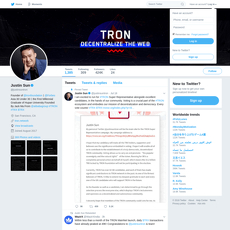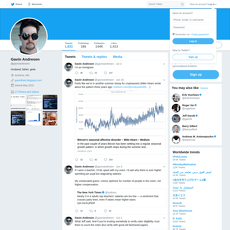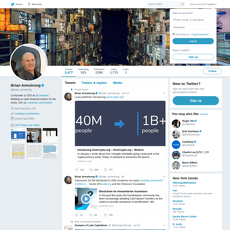Ed_NL Review
Ed_NL
x.com
Should You Follow @Crypto_Ed_NL on X? An Honest, No-Hype Review and How to Use His Charts Safely
Ever stared at a clean Bitcoin chart on X, felt that “I should act now” itch, and then watched price do the exact opposite? Yeah—same. The question isn’t just “Is @Crypto_Ed_NL worth following?” It’s “How do I use his posts practically without taking reckless risks?”
That’s exactly what I’m going to help you do here. I’ll show you what to expect from his feed, how I think about reliability without hype, and the simple framework I use to turn any public chart into an actual plan (with invalidation and risk handled first).
What’s the real problem traders face on X?
Too many charts. Not enough clarity. And almost zero context for risk.
- Timeframe confusion: A 15-minute scenario can totally conflict with a daily bias. If you don’t map the timeframe first, you’ll chase both and regret it.
- No invalidation = no plan: Without a clear “I’m wrong here” level, a chart is just art. Crypto moves fast—you need a line in the sand.
- Volatility whiplash: You see “breakout,” enter late, get wicked out, then watch price run after you stop. Classic.
- Signal overload: Following five analysts with five opinions produces paralysis, then FOMO.
There’s research backing how risky social-driven trading can be. A well-known study by Barber & Odean found that high-turnover retail trading tends to underperform—often because people react to attention and chase noise. And in crypto specifically, multiple papers have shown that social sentiment can heat up tops and bottoms, which is great for awareness but dangerous if you treat posts like orders. Translation: use analysts for structure, not for impulses.
What I’m promising you here
I’ll break down what Ed’s feed gives you (style, strengths, limits), and then show you the smarter way to plug it into your process. That means:
- How to read his scenarios without guessing
- How to mark invalidation and set alerts
- How to size risk so one idea never wrecks your week
- What traps to avoid when using any public chart
Example of the kind of thing you might see (paraphrased):
“BTC: Two paths: A) hold 64k and push to 66.5–67k. B) lose 64k, tag 62.8k liquidity. Invalidation: a clean close below 62.5k for A.”
Looks simple, but if you don’t set alerts and define your trade size/risk first, it’s easy to overreact.
Who this is for (and who should skip)
- For you if: you follow traders on X and want a clear, practical way to use their charts without blowing up your account.
- For you if: you like scenario-based thinking—“if A, then B”—and want help turning that into alerts and rules.
- Skip this if: you want guaranteed signals or plan to copy trades blindly. That’s not the game here, and it won’t end well.
What you’ll learn quickly from this guide
- What Ed posts:quick charts, scenario paths (A/B), and levels that are great for setting alerts.
- How often and what markets: mostly BTC and majors, with timely updates around key pivot zones.
- How reliable it feels: not promises—just consistency signals to watch for, like timestamped posts, clear invalidation, and revisits.
- How to sanity-check: align the timeframe, test levels on your own chart, and avoid entries without invalidation.
- FAQ highlights: Is he legit? Does he sell signals? Is this beginner-friendly? How should you protect yourself while learning?
Bottom line: Ed’s feed can be genuinely useful if you like crisp scenarios and easy-to-watch levels—but only if you pair it with your own risk rules. I’ll show you how I do that step by step.
Curious who Ed actually is, what tools he leans on, and how he frames his scenarios so cleanly? That’s exactly what I’m unpacking next—ready to see what he’s known for and why traders keep him on their screen?
Who is Ed_NL (aka @Crypto_Ed_NL) and what is he known for?
Ed_NL is a long-standing crypto market voice on X who built his audience by mapping scenarios, not shouting certainties. If you’re scrolling for charts that speak in plain, practical terms—trend, levels, invalidation—his feed delivers exactly that. The tone is calm and measured, the kind of commentary that doesn’t chase headlines but tries to show “what could happen next” and where a view breaks.
What the community expects from him is simple: clean charts on BTC and majors, a likely path (or two), and a clear invalidation level. He doesn’t wrap things in mystique. He’ll sketch the A and B paths, point to the levels that matter, and let you decide if it fits your plan.
“Plan the trade. Trade the plan. Let the market prove you right—or get you out fast.”
Analysis style in plain English
His toolkit looks like classic, no-nonsense technical analysis that many crypto traders use day to day:
- Market structure: higher highs/lows, trend channels, and where the structure flips.
- Fibonacci levels: common retracements like 0.382–0.618 and extension targets for potential take-profit zones.
- Elliott Wave-style roadmaps: labeled waves or simplified counts to visualize impulse vs. corrective phases.
- Key levels and invalidation: a price that says “this idea is wrong,” usually marked directly on the chart.
He frames ideas as conditions, not absolutes. Think “If BTC reclaims X, then Y is on the table; lose Z and this scenario is invalid.” That conditional mindset matters. Research in behavioral finance has repeatedly shown that overconfidence harms trading outcomes, while pre-committing to exit rules helps curb loss aversion (see work by Barber & Odean and decision-making studies on pre-commitment). Scenario mapping nudges you toward probabilities instead of predictions.
What an example post often looks like:
- A clean 1H or 4H BTC chart with a projected Path A (breakout + retest) and Path B (failure + sweep lower).
- Two or three watch levels—for example, a reclaimed pivot, a fib retrace, and a prior high/low.
- An invalidation line that flips the bias and cancels the active scenario.
No “buy now” theatrics—just a roadmap you can plug into alerts and your own rules.
What he covers (BTC, ETH, alts, and big levels)
Most of his feed revolves around the big drivers and the cleanest charts:
- BTC as the main risk barometer, often on 1H/4H for timing and Daily for broader context.
- ETH when it sets up independently or confirms/contradicts the BTC picture.
- High-liquidity altcoins when they have clear structures forming—usually the top names by volume or attention.
- Key levels and pivots that the market keeps testing: reclaimed ranges, range highs/lows, prior weekly levels, and fib clusters.
You’ll frequently see updates when price approaches inflection zones: “break and hold above,” “failed breakout,” “retest coming,” or “this level changes the picture.” That rhythm helps you set alerts rather than live inside the chart.
Transparency and disclaimers
His posts consistently read like education, not signals. Expect the usual “not financial advice” tone, but more importantly, expect visible uncertainty when it’s warranted. You’ll often see:
- Multiple outcomes labeled: a primary path and a clean alternative so you’re not forced to guess.
- Explicit invalidation: the line in the sand that flips bias and tells you to stand down.
- “Wait for confirmation” language: a reminder that levels matter only if they break and hold.
This is the kind of transparency that lets you be an adult with your plan. No hype, no guarantees—just clear conditions. That’s rare enough on X to be valuable on its own.
Want to know exactly how this shows up in your feed—chart formats, how often he posts during fast moves, and what’s realistically useful for everyday traders? I’ll show you next, including how to turn those levels into ready-to-go alerts without chasing candles. Ready to see what you actually get by following @Crypto_Ed_NL day to day?
What you actually get from following @Crypto_Ed_NL
If you want fast, chart-first insights without a wall of text, his feed delivers. It’s the kind of stream you can glance at during a work break and still walk away with clear levels to watch and simple “if this, then that” scenarios. No fluff. Just structure.
“Clarity beats certainty.” In crypto, you won’t get guarantees—but you can get a clean map.
Post format: quick charts, scenario paths, and key levels
Expect compact charts with one or two paths marked, the do-or-die level, and a short note on what invalidates the idea. It’s geared for traders who set alerts and wait for price to come to them.
- Quick charts: A screenshot with levels and arrows—usually 4H, 1H, or M15 when volatility spikes.
- Scenario A/B: “Reclaim X and we target Y; reject X and look for Z.” Simple, conditional logic.
- Key levels: Prior highs/lows, obvious S/R flips, and fib/pivot areas that many traders watch.
- Invalidation: A line in the sand. If price crosses it, the scenario is off. This is the most useful part.
Example structure (for illustration only): “BTC 4H—A: reclaim 66.4k → 68.2k/69k. B: reject 66.4k → 64.6k/63.8k. Invalidation for A: close back below 65.1k.” That’s the type of post that lets you set two alerts and walk away.
Why this matters: short, scenario-based charts reduce impulsive trades. Behavioral studies show that traders who predefine conditions are less prone to FOMO and loss-chasing. In plain English: clear scenarios keep you from pressing random buttons.
Frequency and timing
He posts when it counts, not on the minute. You’ll see more updates when the market is moving and fewer when it’s chopping sideways. Typical rhythm:
- Before or during key sessions: Often around the London/NY overlap or ahead of major levels.
- During fast markets: Expect quicker follow-ups—especially if a level breaks or invalidation hits.
- Quiet periods: Fewer posts, but the big levels usually remain valid until price proves otherwise.
What this means for you: set alerts at his levels, not your clock. When an alert fires, check his latest post for context before acting. If there’s no new post, the last invalidation and levels still guide the plan.
Educational value vs. pure signals
It’s not “buy here, sell here” copy-trading. You’ll learn how to think in scenarios and manage invalidation, which is where most retail traders struggle. This is valuable because it nudges you toward a rules-based approach, not impulse moves.
- What you’ll learn: How to map paths, pick the level that flips bias, and stop hunting for certainty.
- What you won’t get: One-size-fits-all entries with exact position sizes or guaranteed outcomes.
There’s good evidence this style helps. Research on checklists and decision hygiene shows that predefined criteria reduce error rates under pressure. In trading terms: scenarios + invalidation + alerts can cut down emotional trades.
Track record feel (without hype)
Forget victory laps and cherry-picked screenshots. The way to judge any analyst on X is simple and boring:
- Consistency: Are the levels and scenarios coherent over time, or do they change every few hours?
- Clarity of invalidation: Does he tell you where the idea is wrong, or is it vague?
- Timestamps and revisits: Are ideas posted publicly, then revisited when they play out or fail?
A practical approach is to keep a tiny log: date, market, scenario A/B, invalidation, outcome. It takes a minute and it kills hindsight bias. As Philip Tetlock’s forecasting work showed, calibration and accountability beat confidence theater. You don’t need a “guru”—you need clean, testable statements you can verify.
So, you get quick charts, clear scenarios, and levels that translate into alerts. The next step is turning that into a plan you can actually trade without blowing up—want the exact checklist I use to convert a tweet into a risk-defined setup?
How to use Ed_NL’s ideas without blowing up your account
Following @Crypto_Ed_NL can be super useful—if you translate what you see into a structured plan. Tweets are hints, not orders. Your edge comes from execution: clear invalidation, consistent risk, no chasing.
“The market can stay irrational longer than you can stay solvent.” — often attributed to Keynes. Translation: survival first.
My 5-step checklist for using analyst posts
Here’s the fast filter I run on any public TA (including Ed’s):
- Map the bias. What’s the main idea? Up, down, or chop. If Ed outlines A (bullish) and B (bearish), note both—but choose the one price is validating now.
- Define invalidation. The price where the idea is wrong, not “less likely.” No invalidation = no trade. I write it as a level, not a feeling.
- Pick your timeframe. Is his chart 1h, 4h, or daily? Match your plan to that timeframe. A 1h idea with a daily stop is how accounts vanish.
- Set risk per trade. I cap at 0.25%–1% of my account per trade depending on volatility. Research from Ralph Vince and Van Tharp shows risk-of-ruin collapses when you keep risk tiny and consistent.
- Pre-place alerts (not market orders). Let alerts at his level do the work. Barber & Odean’s “Trading Is Hazardous to Your Wealth” shows overtrading and impulse decisions kill returns.
Simple rule: ideas are free; risk isn’t. Pay the least for being wrong.
Converting a tweet into a trade plan
Let’s say Ed posts a BTC roadmap: Scenario A = bounce from 65k toward 66.8–67.5k; Scenario B = break 64.8k and target 63.5k. Here’s how I turn that into something I can actually execute:
- Entry zone: 65,050–65,250 after a strong 1h candle reclaim of 65k and RSI recovering above 50.
- Invalidation: 64,700 (close back below and I’m out).
- Take-profit 1: 66,200 (reduce 50%).
- Take-profit 2: 67,400 (trail stop under the last higher low on 15m).
- Max loss: 0.5% of account.
Position sizing example (numbers for illustration):
- Account: $10,000
- Risk per trade: 0.5% = $50
- Entry: 65,200; Stop: 64,700 → risk per BTC = $500
- Position size: $50 / $500 = 0.10 BTC exposure
Fees and slippage exist, so I mentally round down on size. If price never tags my entry alerts with confirmation, I don’t force it. Missed trades are cheaper than bad ones.
On alts, I add one filter: I want BTC either neutral or aligned with the trade. Shorting alts while BTC is breaking out is like standing in front of a train.
What to do when scenarios split (A vs B)
Ed often maps two paths. I turn that into conditional “if/then” rules so I never guess:
- If A triggers: Reclaim and hold 65k on 1h with volume → run the long plan above. The moment I’m in A, B is off the table until invalidation hits.
- If B triggers: 64,800 breaks and retests as resistance on 15–30m → consider short toward 63,500 with a stop above the retest high. No retest, no trade.
- Mutual exclusivity: Only one plan can be active at a time. Flipping back and forth is how you donate fees to the exchange.
- Time decay: If neither trigger fires within my session window (say, 6 hours), I cancel the plan. Fresh charts, fresh mind.
Why this works: scenario planning reduces FOMO and prevents “I think it’ll go up” guessing. As Taleb puts it, survival > prediction. You don’t need to know the future; you need rules when the present changes.
Tools that pair well
- Charting:TradingView for levels, alerts, and multiple timeframes. I add alert notes like: “Only long if reclaim + 1h close + volume.”
- Alerting: Phone push or email tied to keywords like “reclaim,” “retest,” and “invalidation.” Fewer alerts, more action.
- Position size calculator: Use the simple formula: Size = (Account × Risk%) ÷ (Entry − Stop). Prefer a fixed risk per trade over “gut feel.”
- Journal: A one-pager in Notion/Sheets with columns for: Date, Pair, Bias (A/B), Entry, Stop, TP1/TP2, Risk $, R-multiple, Screenshot link, Lesson. I aim for process wins, not just PnL.
- Market context: Coinglass for funding/liquidations and Coinalyze for OI/volume. I’m cautious taking countertrend trades when OI is expanding fast with strong trend candles.
Pro tip: If you struggle with exits, set staggered TPs and trail the stop under the last structure pivot. A study of trend-following systems shows that partial profits plus trailing stops can improve risk-adjusted returns by smoothing equity curves, even if win rate drops. Your future self will thank you for the steadier ride.
None of this is about being right all the time. It’s about keeping losses tiny and letting winners breathe. Want to know where @Crypto_Ed_NL shines, where he doesn’t, and what red flags to avoid while you use any TA feed—so you don’t get trapped by copycats or cherry-picked screenshots? Keep going…
Strengths, limits, and red flags to watch
I like to keep this simple: what does following Ed_NL actually help with, where does it fall short, and what nonsense should you avoid along the way? Here’s my honest, practical take.
Where he’s strong
When I scroll Ed’s feed, a few strengths pop every time—especially if you’re trying to turn noise into a plan:
- Clean levels that matter: He highlights price zones you can actually use. Think “BTC resistance ~$69.5k–$70.2k; reclaim + hold = continuation” or “Invalidation if 4h closes below $66.3k.” That’s actionable—set alerts and move on.
- Scenario mapping (A/B paths): Instead of “to the moon” charts, you’ll often see two outcomes with a trigger. For example: “A: sweep $66k then bounce; B: break and hold below $66k = lower.” That reduces guesswork and helps you plan both sides.
- Tempo that fits crypto: Posts tend to match the speed of the market. During acceleration or key level tests, you’ll usually see quicker updates that keep the structure clear.
- Visual clarity: Quick charts with arrows and invalidation zones can be faster to digest than long threads. In fast markets, speed of understanding is edge.
“Strong opinions, loosely held.”
— a great mindset for trading scenario-based TA with clear invalidation
Real-world sample you might see from a TA feed like his:
- BTC 4h: “Still bullish while above $66.3k. Expecting a push into $69.8k–$70.5k. Invalidation: 4h close below $66.3k = step aside or short retest.”
- ETH 1h: “If we reclaim $3,220 with momentum, $3,320–$3,360 next. Lose $3,120 and I’m looking lower to $3,040 support.”
Those are the kinds of notes that help you set alerts and build a plan before price gets there, not after.
Limits you should expect
No public feed is a full trading system. If you treat it that way, you’ll get hurt. Here are the common gaps:
- Risk is on you: You won’t get position-sizing rules or full R-math on each post. Without a max-risk-per-trade and a stop, one bad move can ruin your week.
- Context can be brief: He moves fast; captions are short. If you want deep narratives or macro context, pair his levels with your own research.
- Timeframe mismatch risk: If a chart is 1h or 4h but you’re trading 5m scalp speed, you’ll feel “late” or “wrong” even if the idea is right on its timeframe.
- Scenario flip-flops are normal: When price invalidates A, good TA switches to B. That’s discipline, not inconsistency. But if you chase every switch without a plan, you’ll churn.
One more thing: social feeds can amplify FOMO. There’s well-known behavioral research (Barber & Odean, 2000) showing that frequent, impulsive trading typically underperforms. Treat posts as inputs, not orders.
Red flags to avoid in this niche
This space is loaded with scams that piggyback on known profiles. Protect yourself:
- Impersonators: Look for near-identical usernames with an extra underscore or letter. Always verify the exact handle: @Crypto_Ed_NL.
- Fake “VIP” DMs: If someone messages you “special signals” or asks you to send crypto, it’s a scam. Real analysts don’t cold-DM for money.
- Cherry-picked screenshots: Scammers post only the wins. A genuine feed timestamps ideas, shows invalidation, and revisits outcomes—even when they’re not perfect.
- Too-good-to-be-true promises: “Guaranteed 95% win rate” or “triple your account this week” is pure bait. Markets don’t work like that.
- Off-platform payment links: Don’t click random Google Drive or Telegram links claiming “official VIP.” Always check the link on the verified profile first.
Quick verification habits that have saved me headaches:
- Confirm the handle from an older, well-engaged post or a link shared by other reputable traders.
- Cross-check tone and posting style. Impersonators often feel pushy or “salesy.”
- Never send crypto to “support” or “giveaway” addresses. That money is gone.
How he compares to other analyst types
Ed’s feed is primarily chart-based. That’s useful—but it’s one lens. I get better results when I pair it with complementary sources:
- TA-focused (like Ed): Great for levels, invalidation, and timing. Helps you decide where and when.
- On-chain analysts: Offer big-picture flows (exchange reserves, whale activity). Good for conviction but slower to time entries.
- Macro commentators: Track DXY, rates, liquidity, and risk appetite. Useful for trend bias across weeks to months.
- Quant/stat traders: Provide probability bands, volatility regimes, mean-reversion or momentum stats. Helps set expectations and avoid chasing.
- News/flow accounts: Fast coverage of ETF flows, listings, or regulatory headlines. Great for catalysts; not a strategy by itself.
A simple blend that’s worked for me:
- Use Ed-style levels to frame entries and invalidation.
- Check a quant or volatility feed to gauge how aggressive to be (position size, target distance).
- Scan on-chain or macro to sanity-check trend direction and avoid countertrend hero trades.
The bigger point: a TA feed gives you the map; your risk process is the steering wheel. Without both, you’re just along for the ride.
Want the exact way I set up alerts, filters, and a one-page note so I can act fast without guessing? The next part walks you through my routine step by step—ready to make your feed actually work for you instead of against you?
Getting started: follow, filter, and build a routine
Set up your feed and alerts the smart way
First step: make sure you’re seeing the right posts at the right time. I keep it simple and noise-free.
- Follow the source: Hit follow on @Crypto_Ed_NL and turn on post notifications. I prefer “All posts” so I don’t miss fast updates during volatile sessions.
- Build a clean List: Create an X List called “Core TA” and add only high-signal analysts. Open that List when you trade—no memes, no drama, just levels and scenarios.
- Mute the clutter: In X settings, add muted words like “giveaway,” “airdrop,” “WL,” “gm,” and “alpha” to keep your focus. Also consider disabling Retweets from noisy accounts.
- Use keyword filters: Create a saved search or X Pro column for from:Crypto_Ed_NL invalidation OR breakout OR retest. These are the words that usually mean “do something or prepare to.”
- Turn charts into platform alerts: When Ed posts a level, I mark it on my chart and set alerts:
- Crossing alert at his invalidation (so I’m out, no debate).
- Crossing alert slightly above/below a breakout level (so I act on confirmation, not hope).
- Retest alert right at the level he flagged for a possible bounce/flip.
Why this works: pre-committing to “if–then” triggers reduces impulsive errors. Behavioral research on implementation intentions shows people follow plans far more consistently when the trigger is predefined. In trading terms: alerts beat FOMO every time.
Micro-example: if Ed posts “Scenario A: BTC holds 69,000 → push to 70,500; invalidation 68,600,” I set:
- Alert 1: BTC crossing up 69,100 (ready to act on strength).
- Alert 2: BTC crossing down 68,600 (instant exit—no second-guessing).
- Alert 3: BTC touching 69,000 (potential retest entry if it holds).
Now I don’t babysit charts or chase green candles. I wait for my pings and execute my plan.
Build your “Ed notes” template
I keep a one-pager for each active idea. It’s fast to fill, even on mobile, and it prevents “I’ll remember it” mistakes (you won’t). Copy this structure and keep it visible:
- Pair & timeframe: BTC 1h
- Bias (why): Bullish while structure holds; expecting continuation if key level reclaims
- Key levels: 69,000 support, 69,500 trigger, 70,500 target zone
- Invalidation: 68,600 1h close below
- If/Then scenarios:
- If price reclaims 69,500 and retests/holds → long to 70,500 (TP1) and 72,000 (TP2)
- If price breaks 68,600 and closes below → stand aside or short to 67,200
- Risk per idea: 0.5% of account
- Entry plan: Limit on retest, or market on reclaim with tighter stop
- Notes: No trade if volume is weak or if news event hits within 30 minutes
Rule: If invalidation triggers, I’m out. Not “let’s see.” Not “one more candle.”
Filled example (realistic numbers):
- BTC 1h — Bias: Slightly bullish above 68,950.
- Key levels: 68,950 (support), 69,480 (trigger), 70,800 (TP1), 72,400 (TP2).
- Invalidation: 68,500 (1h close).
- If/Then:
- If reclaim 69,480, then long on retest toward 70,800 (trim), let runner for 72,400.
- If 68,500 breaks and closes, cancel longs; consider short to 67,300 with tight invalidation back above 68,900.
- Risk: 0.75% on first fill. No stacking if VIX spikes or BTC 5m shows blow-off.
This is boring on purpose. Boring wins. Studies on overtrading (Barber & Odean) show impulsive activity erodes returns; simple written rules curb that impulse.
Extra resources worth checking
- Charting + alerts: Mark his levels, color-code scenarios A/B, set “Crossing” alerts with SMS/push.
- Position size calculator: Lock in your risk per idea so a wrong call is just a scratch, not a crater.
- Journal template: Screenshot the tweet, your chart, and your P/L. Tag with “followed Ed scenario A/B.” Over a month you’ll see what you actually executed—not what you think you did.
- Automation: Route alerts to a channel you’ll read (mobile push > email). Reduce taps between alert and action.
Quick data point: traders who journal reduce hindsight bias and stick to rules more consistently—exactly what you need when markets whip and narratives flip.
My quick-start routine
Here’s the routine I run daily so following @Crypto_Ed_NL translates into calm decisions instead of emotional trades.
- Morning (your local market open):
- Scan Ed’s latest posts for updated invalidations or scenario shifts.
- Update my chart lines to match his key levels; set/refresh alerts.
- Write or tweak my “Ed notes” one-pager for BTC, ETH, and 1–2 alts max.
- Mid-session:
- If an alert triggers, execute the pre-written plan. No plan? No trade.
- If scenarios split (A vs B), I cancel the inactive one the moment the other triggers.
- Late session:
- Log the outcome and a screenshot. Tag “followed plan” or “deviated” (brutal honesty helps).
- Reset alerts for overnight only if they’re part of a written plan. Otherwise, sleep easy.
One tiny rule that saved me: a 5-minute timer. When an alert fires, I wait up to 5 minutes to confirm the candle close or the retest hold—unless my plan clearly says “instant market” on reclaim. That small pause filters the worst fake-outs without turning me into a statue.
You’ve got the system; next comes the question everyone asks but rarely answers well: how do you tell if an analyst like Ed is legit, whether he sells signals, and what kind of accuracy you should expect? That’s what I’ll tackle next—clear, no fluff. Ready for the straight answers?
FAQ and final verdict on Ed_NL (Crypto_Ed_NL)
Is Ed_NL legit or a scam?
He’s a recognizable TA voice on X, and the right way to think about “legit” in this context is: does the account behave like a transparent market analyst, or like a farm for paid DMs and fake screenshots? With the real profile you’ll see consistent posting history, scenario-based charts, and a clear “this is not financial advice” tone. Those are good signs.
Here’s how I sanity-check any analyst account fast:
- Handle and history: Only follow @Crypto_Ed_NL. Look for years of posts, not a fresh account with recycled content.
- Timestamped calls: Are ideas posted in real time with levels you can verify later, or just cherry-picked after the move?
- Invalidation: Real analysts talk about what proves them wrong. Scammers don’t.
- DM behavior: The legit profile won’t cold-DM you for “VIP signals.” Impersonators do.
Impersonator red flags to avoid:
- Slightly misspelled handles (extra letters, underscores, or swapped characters)
- Brand-new accounts with big claims and low-quality engagement
- “Limited-time” paid groups in DMs or short-link redirects to shady payment pages
Does he sell paid signals or groups?
If there’s ever a legitimate offer, you’ll see it linked directly from his official profile or pinned post—not via DMs. Always verify links on the real handle first. In general, I treat any unsolicited Telegram or WhatsApp invite as an automatic block. Education or market commentary is not the same as “signals,” and anyone blurring that line in private messages is a risk you don’t need.
What strategy does he use?
Expect high-level technical analysis with scenario mapping. Think structure, key levels, Fibonacci confluences, and Elliott Wave-style roadmaps. The value is in the “A vs. B” planning and clear invalidation levels, so you can set alerts and decide ahead of time how you’ll react.
A typical example of how I’d translate a public TA post into my own plan:
If price reclaims 66.0–66.3k on momentum, I’ll look for a continuation into 67.2–67.8k. If it rejects and loses 65.1k, I expect a pullback into 64.2–64.6k. Invalidation for long idea: sustained trade back below 65.0k.
That’s the essence: two clear paths, one invalidation per idea.
How accurate are his calls?
No one is consistently “right” in crypto. It’s about probabilities and risk control. What I care about is consistency in process: are levels clear, are invalidations honest, and are scenarios revisited openly?
If you want a practical way to judge accuracy (without hype):
- Create a simple log: date, idea (A/B), key level, invalidation, and outcome.
- Track whether price respected levels and whether the invalidation would have capped your loss.
- Use the same checklist for every analyst you follow—comparability matters more than any single “win.”
Two useful reads on mindset here: sentiment can move markets short-term (Bollen, Mao & Zeng, 2011), and overtrading kills returns (Barber & Odean, 2000). Treat every call as a probability, not a promise.
Is following him good for beginners?
Yes—if you treat the feed as learning material and practice scenario planning with small risk or paper trading first. You’ll pick up how to think in levels and invalidations, which is the foundation of not getting chopped up.
No—if your plan is to copy blindly. That’s where FOMO and overconfidence creep in, two behaviors linked to poor outcomes in trading research. If you’re new, cap risk per trade (I like 0.5–1% of account), write the plan before you click, and review weekly.
How should I protect myself when using any analyst’s content?
- Always have invalidation: The exact price that proves the idea wrong. Place the stop. No exceptions.
- Position size like a pro: Risk a fixed small percent per idea—consistency beats bravado. If you’re curious, even Ed Thorp’s work suggests using a fraction of Kelly for survivability (Thorp, Kelly Criterion).
- Plan A/B beforehand: If A triggers, B is off the table. This kills hesitation and chasing.
- Use alerts, not willpower: Set alerts at the analyst’s levels and walk away until they ping you.
- Journal outcomes: Short notes, screenshots, and whether you followed your own rules. Checklists reduce mistakes under pressure.
Final verdict
My take: @Crypto_Ed_NL is a useful TA voice to keep on your screen, especially if you like clean scenario mapping and pragmatic levels. He adds signal to a noisy feed. Just remember the golden rule:
Use posts as inputs, not orders.
Pair his ideas with your own rules, define invalidation, size positions sanely, and you’ll get the benefit of experienced eyes without taking reckless risks. That’s how you turn public TA into a durable edge.
CryptoLinks.com does not endorse, promote, or associate with Twitter accounts that offer or imply unrealistic returns through potentially unethical practices. Our mission remains to guide the community toward safe, informed, and ethical participation in the cryptocurrency space. We urge our readers and the wider crypto community to remain vigilant, to conduct thorough research, and to always consider the broader implications of their investment choices.













